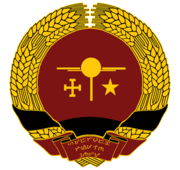Headquarters of the Janpian Union of Revolutionary Forces
| Headquarters of the Janpian Union of Revolutionary Forces | |
|---|---|
 Front Facade of the Headquarters | |
| General information | |
| Architectural style | Haussman Architecture |
| Address | Paliskaya Street, Fort Kalinka, Union District, Kalingrad City 2200 |
| Current tenants | General Revolutionary Staff of the Janpian Union of Revolutionary Forces |
| Construction started | April 14, 3E6 |
| Completed | October 19, 3E8 |
| Owner | Janpian Union of Government Workers' Party |
| Website | |
| www.jurf.gov.jur | |
The Headquarters of the Janpian Union of Revolutionary Forces (Hanosche Riyo no Revolutsiya Arusye no Kutschel) also known as the Revolutionary Council Headquarters, is a building located in Fort Kalinka. It serves as the general staff headquarters and operations of the four Revolutionary branches, namely the Janpian Union of Revolutionary Army (JURA), Janpian Union of Revolutionary Navy (JURN), Janpian Union of Revolutionary Air Force (JURAF), and the Janpian Union of Revolutionary Missileers (JURM). The building has many metonyms, such as "Stables" or simply "Grand Barracks", which are mostly used as codenames among the Revolutionary Forces.
The building's design and construction coincided with Fort Kalinka modernization at that time, where the facilities of the fort was revitalized to fit in newer cannons as well as the necessary accommodations for gunpowder, projectiles, and soldiers. Additionally, the revitalization further thickened its brick walls, making them hard to penetrate by small-sized cannonballs and other projectiles. The most recent renovation of the building was after the 4th era Revolution , in which the compound was expanded underground and a stronger steel structure was built over inside the facade.
History
First Building
During the Schonghuescha Era, the site used to be a wooden stable inside a Toriijo Kalinka, a fort under the Janosche Clan. It was constructed in a traditional Janpian Architecture with a smoothen maple wood, and was constructed with no nails applied. Historical reports also stated that it had a feeding area for the horses, as well as a drinking station that utilizes a sophisticated bearing system that takes water from the nearby Munschen River.
Second Building
During the colonial eras, the wooden stable was replaced with a simple brick building meant to serve as a barracks house for the Marquesan soldiers. The design was a 1-story barracks house made to accommodate up to 80 to 120 soldiers on bunks, complete with a rest house and gun armory to provide them easy access to their weapons in case of a night attack.
Following Janpian independence, the Imperial Government has edicted to expand the barracks with the addition of a second floor to accomodate more soldiers, with the 1st floor being designated for other functionary use. Furthermore, the building was also expanded with an east and west wing complete with their own respective courtyards, making it a compound that is fitted to accommodate officers. Additional changes were also made such as the walls being further thickened to withstand small projectiles and flying fragments.
Contemporary
The barracks house sustained damage during the Janpian Revolution , with the east wing as well as its main building being completely destroyed by Revolutionary bombs. After the war, the newly established Janpian Union of Government Workers' Party quickly renovated the building and designated it as the headquarters of the Revolutionary Forces.
Part of the reconstruction included a complete design restoration of its facade, a new central courtyard that replaced the destroyed main building, as well as other upgrades such as its internals being heavily reinforced with a steel structure. They also expanded the main building towards the walls of the Fort Kalinka, in order to accommodate all four branches and their offices. This led to the removal of its running track as well as the garden at its back, which was also a former artillery station during the war. In the 1980s, the building was expanded underground to integrate the growing office and archive requirements. In this way, the structure still retains its historical aesthetic, and at the same time, being able to take in the new functions and other requirements.






